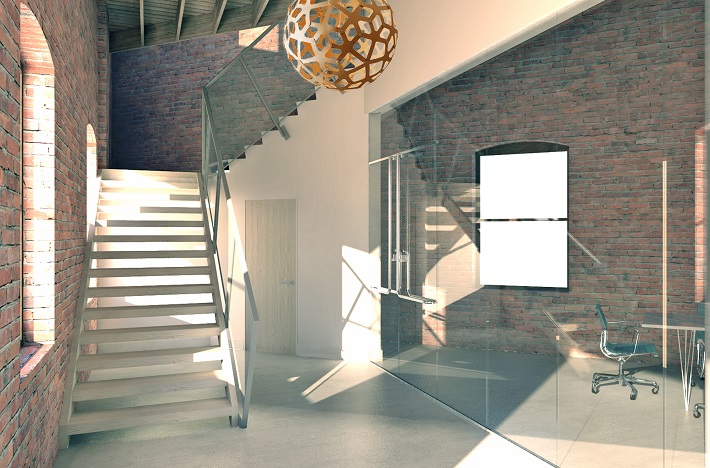When DRAW Architecture + Urban Design moved into its new offices last month, the firm didn’t have far to go. The building is about a block from its old home.
In other ways, though, it’s been something of a journey for Dominique Davison and her team. DRAW is no stranger to working on projects involving adaptive reuse or historic tax credits, but this was the first time the firm had itself for a customer.
Why They Decided to Move
DRAW was coming up on its 10-year anniversary, and business was steaming along. Plus, the lease at the firm’s old building was about to end.
“It seemed like a good time to make the investment,” Davison said.
Staying in the Crossroads was important to her, so she was definitely interested when a friend pointed out the building that would eventually become DRAW’s new home.
“Once I walked in and saw the beams and the brick, I just really loved the feel of the space,” Davison said. “Kind of fell in love with it, even though it’s a funky triangle shape.”
Davison and her husband, Robert Riccardi, decided to buy the building, which includes about 3,000 feet for DRAW and another 1,500 that can be leased to another business—or eventually claimed by DRAW, if or when the firm eventually needs more room.
What They Learned
Davison is upfront: Parts of the remodel have been a challenge.
For example? At one point, the building had been home to a box factory and a print shop. For the past eight years, though, it mostly was an unofficial pigeon habitat.
“There’re so many unknowns you take on when you buy a building like this,” Davison said.
Luckily, there are incentive programs that can help smaller companies more easily afford the cost of a major capital investment. DRAW will receive 50 percent tax abatement for the next 10 years, thanks to the Show Me State’s MissouriWorks programs.
Plus, DRAW has been able to incorporate sustainability features that mattered to the firm, such as energy-efficient LED fixtures and reclaimed wood.
Davison’s other words of advice for business owners mulling over a building purchase:
- Make sure the building has “good bones.” Pigeons aside, DRAW’s is in excellent shape.
- Check with the economic development officials in the neighborhoods where you’re thinking about moving. Small businesses can qualify for incentive programs, too.
- If your project will involve a historic building or historic tax credits, make sure you’ve got a team that’s used to working with those kinds of properties.
The move is giving DRAW not only a new home, but a new perspective on the work it does.
“I think it was a really great experience for us as architects to put on the hat of developers,” Davison said.

